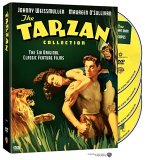Synopsis
Tarzan the Ape Man (1932) follows the safari of Jane Parker (Maureen O’Sullivan)and her father into the jungle world of Tarzan (Johnny Weissmuller). Searching for the elephantgraveyard and the wealth of ivory it would contain, the safari meets all sorts of peril and climbs aforbidding escarpment before they encounter Tarzan. He makes off with Jane, who falls in lovewith him before the movie is out. This film had all the elements that would recur in the rest of theser…es: the safari (one of whose members is a weasel), the hostile natives, the hand-to-handcombat with wild animals, and the comic relief from Cheetah (the chimp whose performance isarguably the most natural in the film).
Much is made in the accompanying documentary of these films being the product of a moreinnocent time. Well, okay, but let’s factor in Tarzan and His Mate (1934), whichunsurprisingly ran into all sorts of censorship troubles. Along with the usual safari perils,Maureen O’Sullivan’s Jane is given the full va-va-voom treatment here with a thigh-highcostume. Then there’s the underwater swimming scene, where O’Sullivan’s stunt double iscompletely nude. This sequence, pretty hot stuff for 1934, is certainly the most erotic underwaterballet in film until 1954’s Creature from the Black Lagoon. This is the most lavish filmof the series, and perhaps the best.
Tarzan Escapes (1936) isn’t on a par with its predecessor, but then (as thedocumentary reveals) suffered a very problematic production history. Once again, a safariintrudes on Tarzan and Jane’s paradise, and the two are separated, leading to Tarzan’s despairand capture (said capture being necessary for him to, well, escape).
Thanks to a plane accident, Tarzan Finds a Son! (1939). More of the same formula ison display here (including re-used footage of a crocodile fight from the second film, which notonly also played a part in the third, but will again in Tarzan’s New York Adventure).With the addition of five-year-old Johnny Sheffield as Boy, the series is becoming more andmore squarely aimed at children.
Tarzan’s Secret Treasure (1941) is pretty formulaic. Once again, a safari arrives withvenal white men (dependably sleazy Tim Conway is the lead villain). The bad guys kidnapTarzan’s family in order to force him to lead them to the treasure of the title.
Tarzan’s New York Adventure (1942) was the last of the MGM series, and the last ofMaureen O’Sullivan as Jane. The finale broke with the formula by sending Tarzan and Jane toNew York to rescue the captured Boy. All kinds of fish-out-of-water adventures ensue.
Formula-bound as the series very quickly became, and meandering as the plotting of even theoriginal was, these movies are terrific entertainment. There is a wealth of incident, with a newdanger confronting the characters every couple of minutes, and there are plenty of spectacularsequences (elephant stampedes, the elephant graveyard, the Brooklyn Bridge dive, and so on). If Imight trouble the notion of the series’ innocence just a bit more, there is another way in whichthese films are a product of their times: the racism is pretty appalling. Non-white characters areinvariably comic relief or disposable cannon-fodder (or both). The first film, for instance, seesTarzan kill several native members of the safari, and nothing is made of this. To expect anythingdifferent of these movies would be unreasonable, but to view the films as the products of avanished golden age of society is just as misleading.
Audio
The audio tracks (all of which are the original mono) vary in quality in direct relation to theage of the film. Thus, the first two films have a lot of hiss and static in the background. By thetime we hit the 1940s, the recording quality is much improved. The dialogue is alwayscomprehensible, but don’t expect miracles from the early films.
Video
The same pattern holds true for the picture, with the early films being extremely grainy, andthe later ones less so. The grain never goes away completely, however, and the prints are prone tominor splices and speckling, and varying degrees of scratches and other damage. No seriousattempt appears to have been made to restore the picture and remove dirt and grain, though thenudity of the second film is back (the footage was found in 1987).
Special Features
For some reason, the films are not presented entirely in chronological order — Tarzan andhis Mate and Tarzan Escapes have effectively swapped discs. At any rate, all of theextras are on Disc 4. The principle feature is Tarzan: Silver Screen King of the Jungle, a73-minute documentary chronicling the making of the series. Film historian Rudy Behlmer doesmost of the narrating. The piece is very informative, though a bit more analysis of the individualfilms would have been welcome. “Schnarzan the Conqueror!!!” is a mock trailer featuring JimmyDurante (lifted from Hollywood Party). “Rodeo Dough” is a short feature, and “MGM OnLocation” is a vintage featurette done during the shooting of Tarzan Finds a Son!. Thereare trailers for all six films (including the animated teaser for Tarzan Escapes). Theintroductory screen for the menus is basic, but once you select an individual film, the menu isscored.
Closing Thoughts
A wonderful nostalgia package. Putting all the films together was a terrific idea. The extrasaren’t bad, but could have been beefed up a bit more yet.
Special Features List
- “Tarzan: Silver Screen King of the Jungle” Documentary
- “Schnarzan the Conqueror!!!”
- “MGM On Location” Featurette
- “Rodeo Dough” Short
- Trailers





